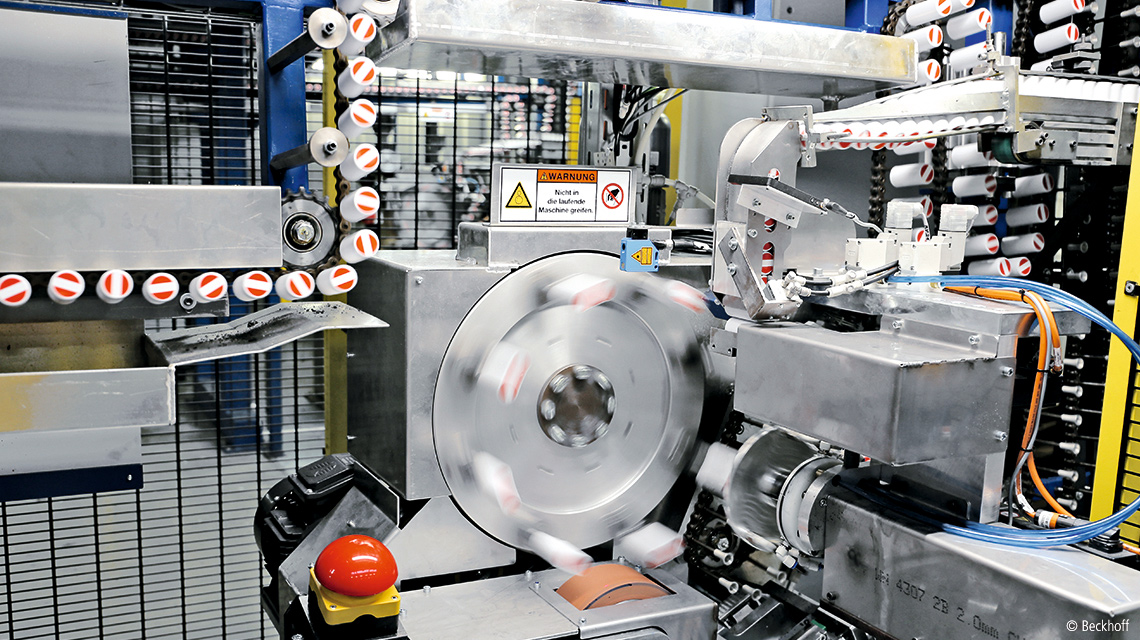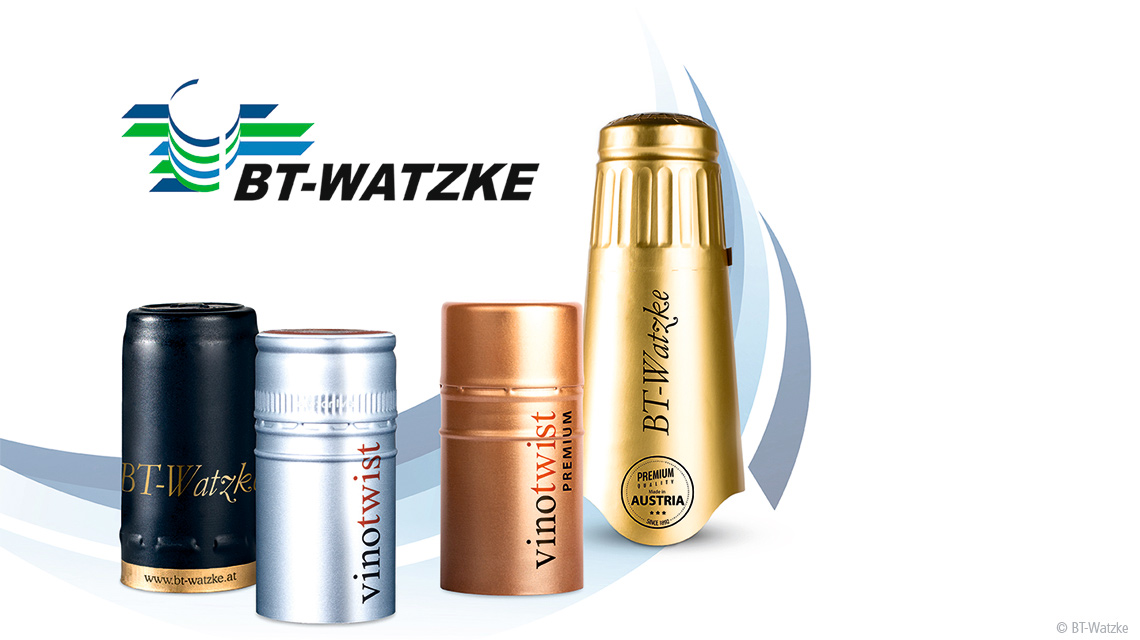

Drive technology from Beckhoff plays an important role at the traditional Austrian company
Bottle caps serve as protection and decoration in one. On the one hand, they shield wines and other beverages outwardly, while on the other hand they act as a decorative design element, lending bottles an unmistakable, individual touch. The design options open to Pinggau-based BT-Watzke are close to endless. That’s because the traditional Styrian company operates its own in-house engineering department combined with machine shop, which allows it to control how it implements customer requirements – no matter how varied. Servo drive technology from Beckhoff Automation likewise plays an important role.
The roots of the Watzke capsule factory date back to the year 1892. Originally founded as a forge, the traditional company based in Pinggau has developed into a premium supplier of bottle caps. The Styrian manufacturer has a customer base ranging from small wine producers to mass bottlers. The export quota is around 85%. “We distribute our products to more than 40 countries, including Germany, Scotland, South Africa, and Tanzania. We even have our own headquarters for the North American market, which is located in Sherwood, in the US state of Oregon,” explains Christian Stanzel, Managing Director of BT-Watzke GmbH.
The customization options offered by the Styrian manufacturer for wine, sparkling wine, spirits, and fruit juice bottles, range from “simple” top and side printing through to sophisticated foil embossing and other typical design features for caps such as breathing or cork ventilation holes, spherical or grid graining, tear-off perforations, or tear-off strips. “Many customers come to us with a template and ask whether we can reproduce the particular design. The fact that we have our own engineering department is tremendously beneficial, since it allows us to cater to individual customer requirements in terms of shape, color, logo, font, etc. If we don’t have the right tools for a pending order, we carry out a feasibility check and, if necessary, upgrade or convert the existing equipment accordingly,” says Christian Stanzel, highlighting the company’s comprehensive manufacturing expertise.

A further special characteristic of BT-Watzke is that it acts as a one-stop supplier – from low-cost heat shrink capsules to high-quality tin capsules. Other options in between offered by the Styrian manufacturer include capsules made from polylaminate film or aluminum. “Apart from ourselves, there is no other producer in the world that can manufacture the complete range of closing products at one location. With our Vinotwist twist caps, which we have been producing since 2007, and an ever-growing assortment of caps, we have developed a range of solutions for closing the most varied types of bottles,” says electrical engineer Daniel Wolf, pointing out the many “facilitator” qualities that characterize the Pinggau-based traditional business. And he must know: at the end of the day, it is usually up to him and his colleague Gerhard Schuller to fulfill the required underlying technical conditions for outputting around 350 million caps per year in cooperation with Workshop Manager Franz Reifbäck and his team.
Perfectly controlled synchronization
BT-Watzke only very rarely purchases ready-made standard machines. “We build almost everything ourselves – and in the way we need it,” confirms Franz Reifbäck. Ultimately, it is important for us to be able to respond flexibly to different customer requirements. Some 100 self-built systems in total are currently in use in the capsule factory in Pinggau – including 14 that “simply” paint. One of these machines was recently extended by an additional part. “Because the lateral surface areas of our twist caps require up to three coats depending on the color, we decided to integrate a third machine into this production process in order to increase throughput rates,” says Franz Reifbäck, explaining why they decided to give this “running system” a helping hand. However, the following optimization measure, in particular, also helped in the end to increase the performance significantly: it was decided to use servo drive technology from Beckhoff to transport blanks rather than a pneumatic solution that had typically been used up to now. “This project involved three individual systems that operate independently but nonetheless have to run synchronously. That’s because they form a unit together with the drying kiln through which every blank to be painted is fed,” says Bernhard Fischer, a member of the sales staff at Beckhoff, describing the task they faced at BT-Watzke.
The transport chain acts as the time base for this application, determining the nominal speed for all manipulations that have to be carried out in the individual machine parts. “We use an EL5151 incremental encoder interface for this purpose, which records the position of the transport chain as a virtual master axis. All subsequent motion sequences are aligned automatically using the cam disc functions available in our TwinCAT automation software,” says Bernhard Fischer, pointing out a simple synchronization feature that the maintenance department of the Pinggau-based factory soon came to appreciate. That’s because the behavior of the drives at maximum output of up to 200 cycles per minute can now be tested at slow speed after every reprogramming. “Regardless of the speed the system is running at, the AM8000 servo motors focus solely on the curve set for them,” says Daniel Wolf enthusiastically about the perfectly controlled synchronization between the newly added machine part and the existing units of the lateral surface painting system. Having to perform reference runs each morning is now a thing of the past. “That was another aspect Beckhoff took into consideration in designing the drive technology. We wanted to be able to start immediately in the morning,” says the electrical engineer, outlining one of a number of small additional requirements expressed by BT-Watzke in this project.
Up to 200 cycles per minute
“We communicated what we wanted and indicated that a solution for up to 200 cycles per minute would be needed in general. We relied to a large extent on the experts at Beckhoff, however, when it came to the finer points of the actual implementation. At the end of the day, they know best what their products can actually do,” says Daniel Wolf, describing the collaboration that started as early as the concept phase and was characterized throughout by an open exchange of ideas and views. Workshop Manager Franz Reifbäck first used his CAD program to design how the additional third machine part needed might look. He then had these proposals assessed and double-checked by Beckhoff employees. Some refinements and deliberations took place alongside too. “I still remember well when Beckhoff’s drive specialist, Leo Büchinger, and I sat side by side in front of the screen. I gave him the weights and diameters relevant at certain points and the associated speeds and, as I looked on, he worked out which components could be considered,” describes Franz Reifbäck. The corresponding CAD data was sent directly to his computer. “The design process couldn’t have gone more smoothly. I didn’t have to call anywhere or send further information; everything was done here locally on site. The whole thing was complete within just a few hours,” he adds.
In addition to numerous EtherCAT input and output terminals, the previously mentioned EL5151 incremental encoder interface, EL72xx servo motor terminals, and an EL9576 brake chopper terminal, the lateral surface painting process at BT-Watzke is now also supported by a CX5130 Embedded PC with an Intel® Atom™ multicore processor and four servo motors from the AM8000 series. The latter ensure attachment or detachment of capsule blanks at the revolver that is synchronized with production cycles. In addition, they manage the movements of this turntable.
“The probability that the attachment would immediately work as we had envisaged was almost 100%, but the removal from the turntable was the greatest unknown. Would everything really work as calculated beforehand? Would the mechanics and electrical drive technology interact properly? Since we had never done anything similar in this way before, there was a certain amount of trepidation before the first real test run,” confesses Daniel Wolf, with the electrical engineer adding: “Simulations are one thing, but everyday production has already proven us wrong on many occasions. A few snags can arise very quickly here and there.” After all, capsules are not all alike according to Franz Reifbäck. “Depending on whether a matt or gloss paint is applied or whether the products being transported are black or green, they behave slightly differently. And the drive technology has to respond to these small but subtle differences,” says the Workshop Manager, stressing that the Beckhoff solution used has to offer maximum adaptability and flexibility.
Trust reduces complexity
The collaboration between BT-Watzke and Beckhoff was very intensive from the outset and built on trust. “Because my colleague Gerhard Schuller and I have to cover a broad range of activities as industrial electricians – from lamp replacement, maintenance, and repair to drawing plans and (re)programming – we clearly needed more support with this first project with a technology provider who was new to us than someone who already has more experience of such matters. In this regard, the local proximity to the Styrian sales office was of great benefit to us, especially since two of our main contacts – Bernhard Fischer and Thomas Maierhofer – don’t live too far away. They were on hand immediately if needed,” says Daniel Wolf, praising the quick response times of the entire Beckhoff team.
Some joint activities have likewise been planned for 2021. Discussions are under way at present in relation to an extension of the twist cap side face painting unit with the addition of energy measurement, the connection to the ERP system, and numerous other conversion or upgrade activities. “Our engineering department always has its hands full because not only is there always something new to design or construct, but also existing equipment to maintain or, if necessary, modernize with the latest electronics,” says Managing Director Christian Stanzel, confirming that some more orders will come Beckhoff’s way soon. “Who knows, perhaps we will want to process data in real time in the future or incorporate image processing, says Daniel Wolf, implying with his remarks where the journey might go from here. With Beckhoff in any case, the Pinggau-based manufacturer has an implementation partner at its side with numerous “facilitator” qualities, just like BT-Watzke. On the one hand, because PC-based control technology “by nature” is finely scalable – both in terms of hardware and software. And, on the other hand, because the entire Beckhoff team invests all its know-how in exceeding and not just meeting the expectations of the customer.
For BT-Watzke, it was primarily the interaction between the “small and large drive technology” in synchronization with production cycles, which at first glance for Franz Reifbäck and Daniel Wolf did not seem so easy to control. But thanks to the cam disc functionality recommended by Bernhard Fischer, even this highly complex task could be solved easily with one software switch for everything. All actual and target positions are transmitted via EtherCAT to the EL72xx servo motor terminals and AX5000 servo amplifiers involved, thus allowing an electronic cam disc to be implemented on the AM8000 servo motors. “We watched closely how several motion sequences are synchronized in TwinCAT 3. Next time we will be able to do it alone,” say Daniel Wolf and Gerhard Schuller, pleased with how much they learned during the intensive collaboration with Beckhoff.